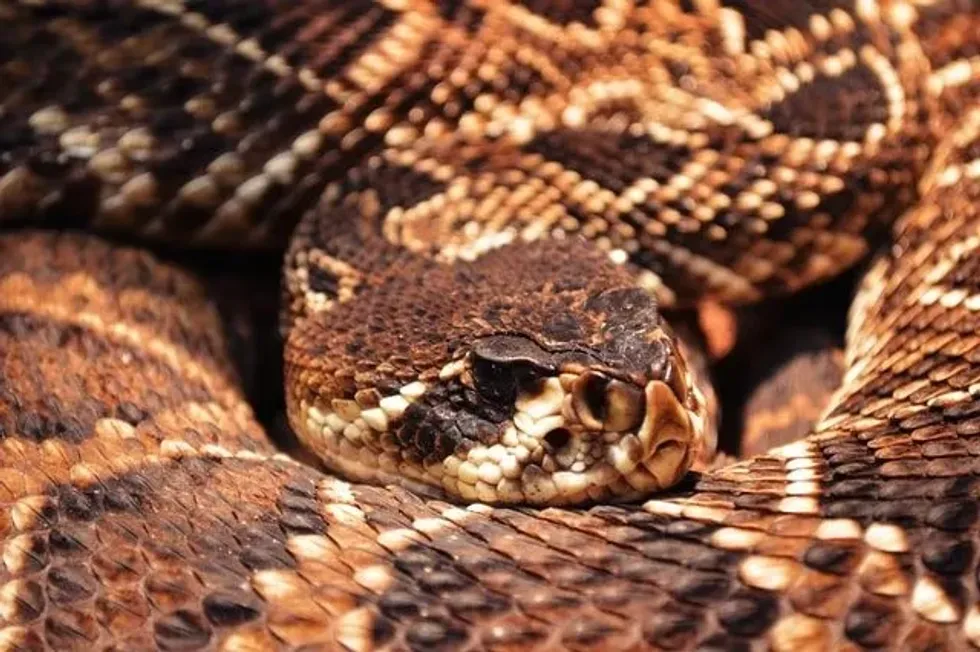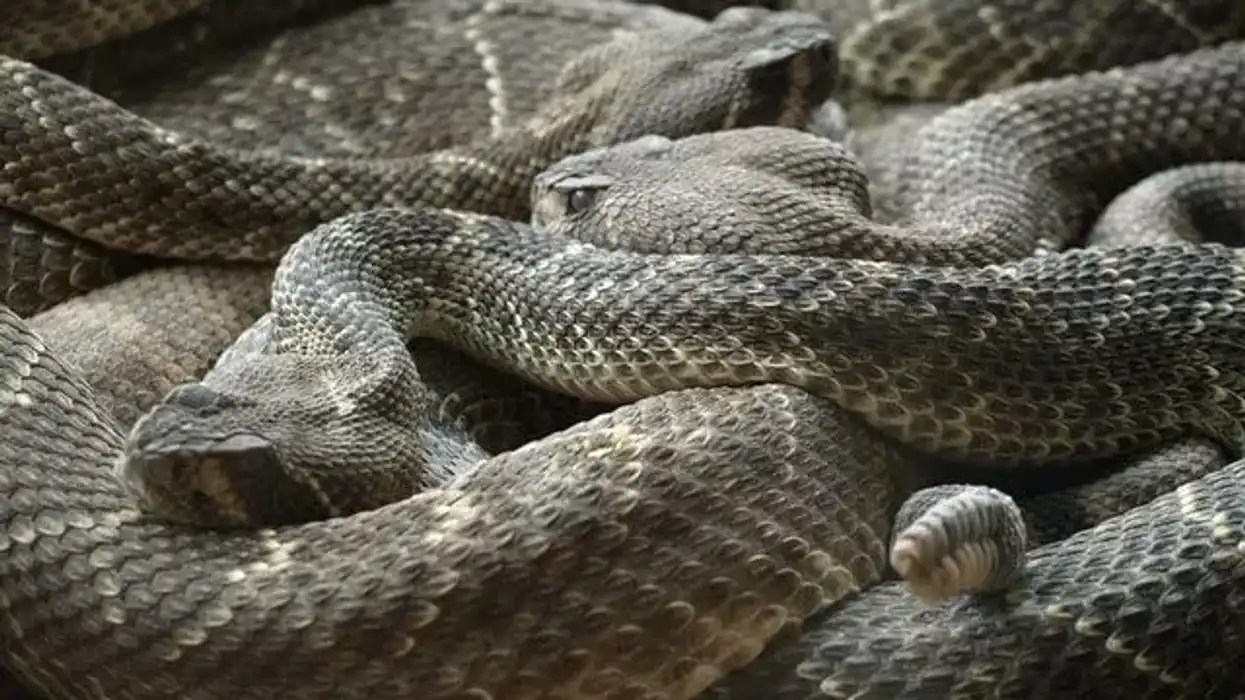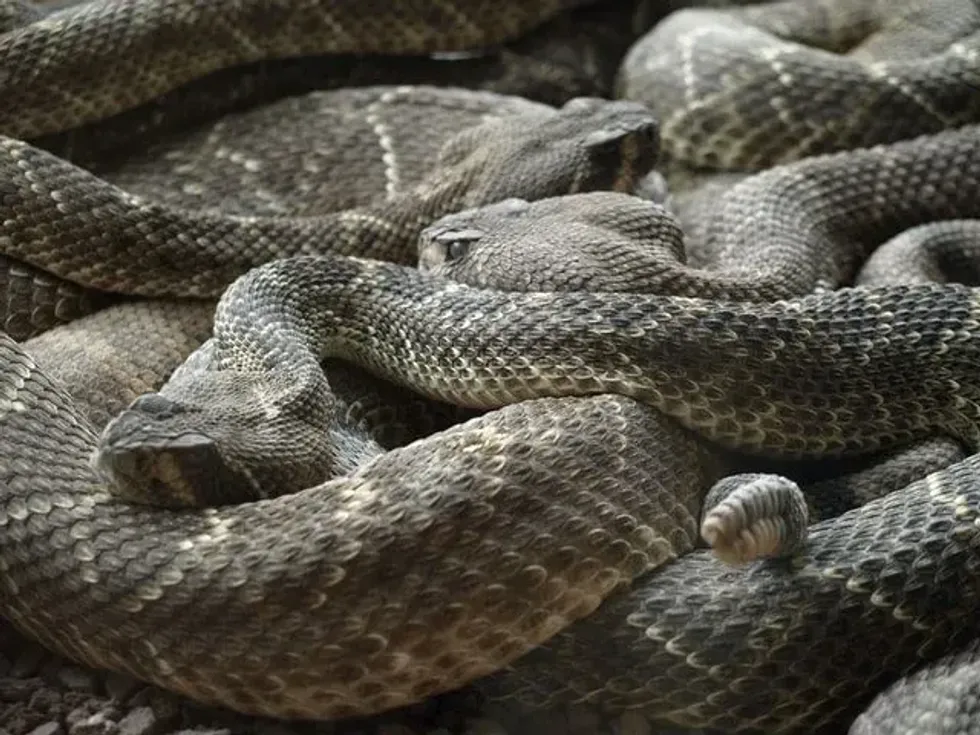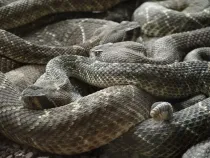Fun Western Diamondback Rattlesnake Facts For Kids

The species of snakes recognized for its notorious bites is the western diamondback rattlesnake (Crotalus atrox). The members of the Viperidae family, Crotalus atrox or western diamondback rattlesnake, are pit-vipers distributed over Central and Western Texas as well as Southern New Mexico and Arizona.
These snakes are named after the dark diamond-shaped patterns found on the back of their body. Though western diamondback rattlesnakes are highly venomous and behold a threatening ambiance, they are quite beneficial in controlling rodents.
Besides their scientific name Crotalus atrox, western diamondback rattlesnakes are also known by numerous other designations.
For instance, desert diamond rattlesnake, buzz tail, Texas diamond-back, or fierce rattlesnake. Then there is the case of the western diamondback rattlesnake, wherein due to a special pigment being missing, these snakes assume an albino color but this leads to their downfall as the albino western diamondback rattlesnake is easily visible to predators.
Some of the most interesting western diamondback rattlesnake adaptations are long, curved, hollow fangs connected with venom glands and a heat-sensing pit located behind each nostril.
In case of roused interest, browse through for some interesting western diamondback rattlesnake facts for kids. After reading the baby western diamondback rattlesnake facts, do check out our other articles on a rattlesnake and eastern diamondback rattlesnake as well.
Western Diamondback Rattlesnake Interesting Facts
What type of animal is a western diamondback rattlesnake?
Western diamondback rattlesnake, scientific name Crotalus atrox, is a group of venomous snakes belonging to the Viperidae family. These members of genera Crotalus are also known as adobe snake, Texas rattler, coon tail, Texan rattlesnake, spitting rattlesnake, desert diamond-back, and Arizona diamond rattlesnake. Western diamondback rattlesnake bites are highly lethal to the victim.
What class of animal does a western diamondback rattlesnake belong to?
Western diamondback rattlesnake (Crotalus atrox) is a species of venomous snakes belonging to class reptilia.
How many western diamondback rattlesnakes are there in the world?
No accurate numbers are allotted to the total population of western diamond-back rattlesnakes. However, these snakes are amongst the 36 species of recognized and reported rattlesnakes of the animal kingdom.
Besides this, western diamondback rattlesnakes are known to be distributed over a wide range of geographical regions. Therefore it can be safely pointed out that their population is quite steady.
Where does a western diamondback rattlesnake live?
Crotalus atrox are natives of the United States. The venomous vipers are locals of western and central Texas as well as larger parts of Mexico, while expanding and covering the terrains of southern California and Arizona.
What is a western diamondback rattlesnake's habitat?
Western diamondback rattlesnake habitat regions are dispensed over a wide range of terrestrial biomes such as sandy creosote areas, pine-oak forests, desert scrub, and mesquite grassland. These snakes also have their habitat in dry and rocky terrains, flat coastal plains, and rural blacktop roads.
Who do western diamondback rattlesnakes live with?
Crotalus atrox, or western diamondback rattlesnakes, are solitary reptiles. These snakes are known to come together and interact amongst their species, mostly during the breeding season.
How long does a western diamondback rattlesnake live?
The lifespan of western diamondback rattlesnakes ranges between 15 and 20 years. However, the longevity of the female members is generally more than the male members of the species.
How do they reproduce?
Western diamondback rattlesnakes are sexually reproducing and viviparous organisms. These snakes generally attain sexual maturity at 3 years of age.
During the breeding season (which generally occurs in the spring), the male Crotalus atrox approaches the female. Following a vigorous jerking of the central part of its body, the male places its tail beneath that of the females. After the positioning, the male inserts its male reproductive organ.
After fertilization, the period of gestation lasts for about 167 days, at the end of which a litter of about 20 to 25 neonates is born. The young ones stay with the mother only for a couple of hours or for a day maximum.
What is their conservation status?
Western diamondback rattlesnakes are categorized as Least Concern on the red list of IUCN. Therefore, it can be deduced that the population of these pit-vipers is unlikely to decline rapidly and can be predicted to be steady.
Western Diamondback Rattlesnake Fun Facts
What do western diamondback rattlesnakes look like?
Anatomically these members of genera Crotalus possess a large triangular-shaped head adorned on a plump body. The spade-shaped head is marked with two dark diagonal lines on each side of its face running from the eyes to its jaw.
The coloring in western diamondback rattlesnakes ranges from dusty-gray-brown to brick red, pinkish, pale blue, yellowish, chalky white, or pinkish-brown. They have alternating black and white bands on their tails.

How cute are they?
With their plump bodies and diamond-shaped texture, these snakes are quite fascinating sights to behold. However, Crotalus atrox cannot be categorized as cute reptiles; they moreover fall under the dangerous classification as this rattlesnake species is extremely venomous and notoriously recognized for its fatal bites.
How do they communicate?
Rattlesnakes usually communicate through their tails and hissing. This rattlesnake species does not communicate that much as they preferably live alone.
How big is a western diamondback rattlesnake?
The average western diamondback rattlesnake size ranges between 48-60 in (4-5 ft). However, Crotalus atrox with a length of 72 in (6 ft), though quite rare are also known to inhabit the terrains of the United States. The world record western diamondback rattlesnake was about 90 in (7.5 ft) in length.
How fast can a western diamondback rattlesnake move?
Though no exact details about the gliding movements of western diamondback rattlesnakes are known, according to studies, these vipers are thought to be excellent strikers. Besides this, these rattlesnakes, like other members of the genus Crotalus, exhibit oscillatory movements in their tails, ranging between 20 to 100 times in just one second.
How much does a western diamondback rattlesnake weigh?
The average western diamondback rattlesnake weight ranges between 3-15 lb (1.3-6.8 kg).
What are the male and female names of the species?
There are no distinct names allotted to the members of the species on the basis of their sex. The males are referred to as male western diamondback rattlesnakes, and the females are known as female western diamondback rattlesnakes.
What would you call a baby western diamondback rattlesnake?
The offspring of a western diamondback rattlesnake is referred to as a baby western diamondback rattlesnake or a juvenile western diamondback rattlesnake.
What do they eat?
Western diamondback rattlesnakes are a group of venomous reptiles. Western diamondback rattlesnake diet comprises small mammals and animals such as prairie dogs, pocket gophers, old-world rats, and mice.
Western diamondback rattlesnakes also prey on birds and other reptiles. Crotalus atrox also hunt down amphibians, small fish, and invertebrates such as spiders, scorpions, beetles, and vinegaroons. Generally, Crotalus atrox are known to hunt during the nighttime and the early hours of the morning.
Are they venomous?
Western diamondbacks are the explicit members of venomous snake families. These members of Viperidae are, in fact, categorized amongst the most venomous inhabitants of the United States.
Owing to its fatal sting, western diamondbacks are known to cause paranoia in humans. The venom of these snakes exhibits proteolytic enzymes which are scientifically proven to impact cells and tissues, destroying their constitution. Large amounts of venom are pumped inside the body of a victim through a single western diamondback rattlesnake bite.
Would they make a good pet?
No, western diamondbacks are inhabitants of the wilderness, this rattlesnake species is extremely venomous, with fatal impacts on other living organisms. Besides this, these rattlesnakes are quite aggressive as well as defensive.
Therefore, owning these reptiles as domesticated pets is not really an excellent idea. Their venomous bite can be lethal to pet animals as well as other family members.
Did you know...
According to the studies of Louisiana University, western diamondbacks are rated amongst the fastest lunging and striking pit-vipers. Western diamondback rattlesnakes are considered as nobility amongst the species of desert rattlers mostly due to their ability to grow over seven feet.
The rattles of the infamous pit vipers Crotalus atrox are made up of the same proteins found in the hair of humans.
When you compare eastern vs western diamondback rattlesnake, then you will notice that the diamond-like patterns on the body of western diamondback rattlesnake are much lighter when compared to the eastern diamondback rattlesnake.
What is the largest western diamondback rattlesnake on record?
The world record western diamondback rattlesnake was about 90 in (7.5 ft) in length.
What to do if you get bitten by a western diamondback rattlesnake?
Due to the extremely venomous composition of western diamondback rattlesnake venom, the dire situation of being bitten by a western diamondback rattlesnake calls for immediate medical attention.
Though rarely fatal, it can be quite dangerous as it may affect your tissue. However, a prolonged gap in treatment may result in internal hemorrhage.
The common symptoms of lethal interactions with western diamondback rattlesnake include one or two puncture marks, swelling, bruising, or discoloration in the bitten area, salivating, lightheadedness, sweating, weakness, blurred vision, slight pain, tingling or burning at the affected site, nausea or vomiting, and numbness in the face or limbs.
After being bitten immediately vacate the surrounding area shared with the snake as it may strike again. Seek medical help as soon as possible. Also while waiting for medical assistance keep the following in mind: try to keep the bitten area at low levels in comparison to your heart.
The arm or leg should not be raised. This is necessary in order to prolong the flow of the venomous blood towards the heart. Allow the wound to bleed, as it will facilitate the expulsion of poisoned blood.
Do not apply cold water or try to suck out the venom. It can prove to be deadly. Try to remain calm after the rattlesnake bite.
Here at Kidadl, we have carefully created lots of interesting family-friendly animal facts for everyone to discover! Learn more about some other reptiles including black rat snake, or copperhead snake.
You can even occupy yourself at home by drawing one of our western diamondback rattlesnake coloring pages.
We Want Your Photos!
More for You
Doctorate specializing in Veterinary Medicine

Oluniyi AkandeDoctorate specializing in Veterinary Medicine
With an accomplished background as a Veterinarian, SEO content writer, and public speaker, Oluniyi brings a wealth of skills and experience to his work. Holding a Doctor of Veterinary Medicine degree from the University of Ibadan, he provides exceptional consulting services to pet owners, animal farms, and agricultural establishments. Oluniyi's impressive writing career spans over five years, during which he has produced over 5000 high-quality short- and long-form pieces of content. His versatility shines through as he tackles a diverse array of topics, including pets, real estate, sports, games, technology, landscaping, healthcare, cosmetics, personal loans, debt management, construction, and agriculture.
Bachelor of Arts specializing in Political Science and International relations

Sakshi KashyapBachelor of Arts specializing in Political Science and International relations
An experienced content strategist, Sakshi excels in helping brands increase their organic reach and revenue streams through creative content. With a focus on lead generation and engagement, she has delivered tangible results for her clients. She is currently pursuing a Bachelor's degree in Political Science and International Relations from Calcutta University while working as a fact-checker.
Disclaimer
1) Kidadl is independent and to make our service free to you the reader we are supported by advertising. We hope you love our recommendations for products and services! What we suggest is selected independently by the Kidadl team. If you purchase using the Buy Now button we may earn a small commission. This does not influence our choices. Prices are correct and items are available at the time the article was published but we cannot guarantee that on the time of reading. Please note that Kidadl is a participant in the Amazon Services LLC Associates Program, an affiliate advertising program designed to provide a means for sites to earn advertising fees by advertising and linking to Amazon. We also link to other websites, but are not responsible for their content.
2) At Kidadl, we strive to recommend the very best activities and events. We will always aim to give you accurate information at the date of publication - however, information does change, so it’s important you do your own research, double-check and make the decision that is right for your family. We recognise that not all activities and ideas are appropriate for all children and families or in all circumstances. Our recommended activities are based on age but these are a guide. We recommend that these ideas are used as inspiration, that ideas are undertaken with appropriate adult supervision, and that each adult uses their own discretion and knowledge of their children to consider the safety and suitability. Kidadl cannot accept liability for the execution of these ideas, and parental supervision is advised at all times, as safety is paramount. Anyone using the information provided by Kidadl does so at their own risk and we can not accept liability if things go wrong.
3) Because we are an educational resource, we have quotes and facts about a range of historical and modern figures. We do not endorse the actions of or rhetoric of all the people included in these collections, but we think they are important for growing minds to learn about under the guidance of parents or guardians.







